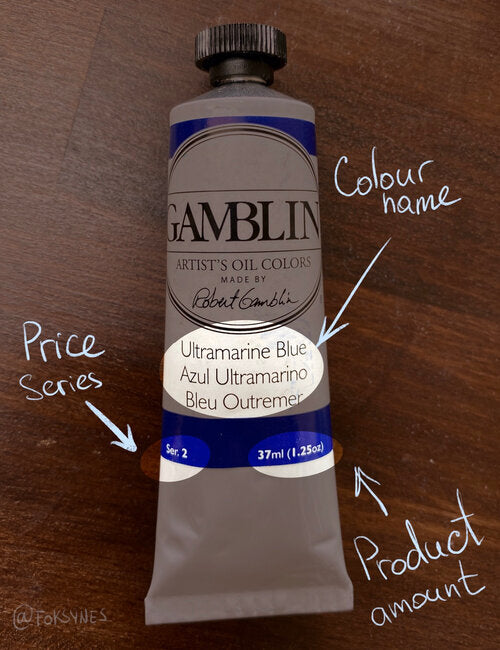
How to choose oil paints
Share
Greetings,
Let's start our adventure in the land of oil colours from basics such as what your tube can tell you about your paints. Principles below can be applied as well for other paint such as watercolour, acrylics.
Each manufacturer will add small variations of symbols which they use or even standards. But almost all of them will state three main things:
-
Name of colour.
Please remember that it is not the name of pigments. Different pigments might be used to represent the same colour—that why it is essential to check them in addition to the colour you buy.
-
Tube capacity
-
Series
which determine the price range of paint
Next three essential things are:
-
Health hazard warnings.
Usually, all respectable manufacturer apply with standards specifications and have to state all known health hazards. You can always ask for the safety data sheet (SDS) or find it on the manufacturer website to know more details.

-
Composition.
Another place where standards are necessary so the manufacturer could not hide additives to oil colours such as fillers and brightener.
Unfortunately, the only proven method to make sure oil paints is clear from unnecessary stuff is to make them yourself. Which will be a headache for many of us :) Ideally, oil paint should consist of two components: pigments and drying oil, such as walnut or linseed oil (vehicle/millbase). Some manufacturer may add fillers (stabilizer, wax, etc.), thickeners to make their products cheaper as pigments might be quite expensive. In reality, it will cause colours less vibrant and even may weaker paint, increase the risk of cracks, etc. They also may try to solve the issue when pigments separate from oil in a tube and give oil paints inconsistent look (which is not a big deal as you can remix pigment in oil). That why it is better to buy from respectful manufacturer artists grade quality paints. Better to buy fewer colours but better quality than many poor produced ones.
For acrylics, I could recommend Golden paints or Amsterdam Expert.
As for oils, I use Gamblin and Old Holland.
If you have someone whose work you admire it worth to check their website to see what materials they use. As an example, Richard Schmid is a well known and experienced artist; you can find a complete list of his materials. Another amazing artist to take a look at Annie Stegg Gerard here is the list on her website.
Watercolours: Winsor & Newton artist grade, Daniel Smith. Van Gogh excellent student grade watercolour choice for beginners.
I have found quite useful to look at Pigments Database to figure out what some pigments code means.
-
Lightfastness
Quite straight forward quality, basically how fast your paint will lose its colour i.e. fade. Manufacturers in different countries may use different standards.
Below you can see a basic description of ASTM standard. Idealy you should use pigments that has excellent/highest lightfastness.
As an example of different labelling approach, Winsor & Newton use in addition to lightfastness Permanence rating, which measures film & chemical stability of the paint.
Other manufacturers use +++ for the highest degree of lightfastness (100+ years under museum conditions) nad + for lowest. As an example, Van Gogh watercolours.
A bit more about the term: https://en.wikipedia.org/wiki/Lightfastness

What hue stands for at the end of the colour name?
Hue at the end of colour name shows that modern alternative pigments were used to produce paint. It is not a bad thing. Reason for this might be too dangerous for health qualities of traditional pigment or that it is not available anymore for paint producers. As an example, Indian Yellow traditionally was made from the urine of cows fed only on mango leaves and water. Not sure if they were happy about it. Check out a bit of history of colours in the article from Guardian.

And if you are interested to know more about History of Colours/Pigments I highly recommend you to read The Secret Lives of Color by Kassia St. Clair. Fascinating reading, even if you are not a painter.
